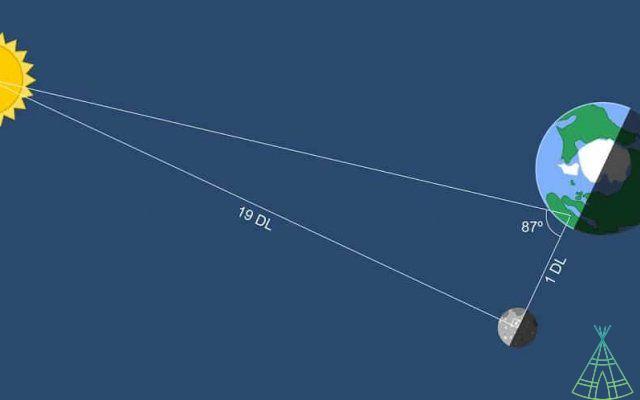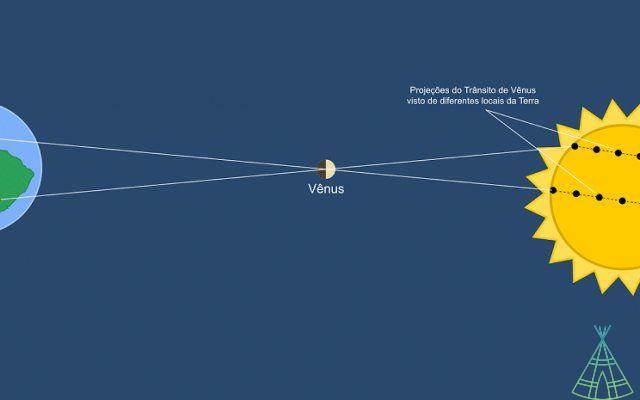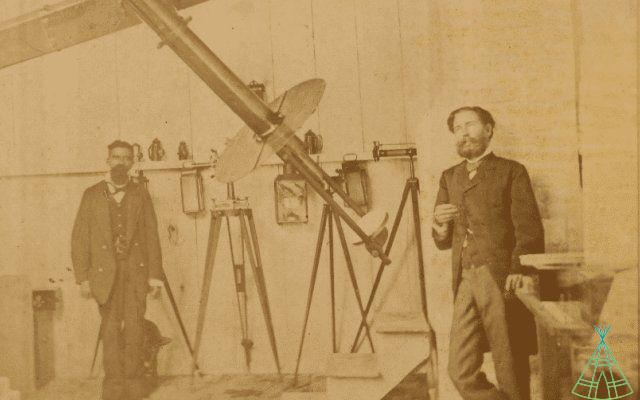The average distance between Earth and the Sun is 149,6 million km. This measurement, also called Astronomical Unit, is the basis for calculating most of the astronomical distances of our Solar System and nearby stars.
Our space missions would never reach other planets, asteroids and etas, if we didn't know their exact positions in space. And this was only possible thanks to a precise measurement of the distance between the Earth and the Sun. But have you ever stopped to think how this distance was calculated?
Watch the Technology Refugee News video:
The first efforts to calculate the distance to the Sun were undertaken by Aristarchus of Samos. Almost 300 years before Christ, Aristarchus had already calculated the distance to the Moon by observing a lunar eclipse and using a coin, a candle and Mathematics. Around the same time, he devised a simple way to measure the distance between the Earth and the Sun.
Knowing that the phases of the Moon occur due to the incidence of sunlight on its surface, Aristarchus concluded that, when the Moon was in First Quarter or Last Quarter, it would form an angle of 90 degrees between it, the Sun and an observer here on Earth. Earth. Therefore, if he could measure the angle formed between the Moon and the Sun from the Earth, he could calculate the distance to the Sun by trigonometry, since he already knew the distance between the Earth and the Moon.

Aristarchus' method was simple and elegant, but the measuring instruments he had available at the time were not as accurate. Therefore, a small error in measurement caused a large error in the result. His calculations concluded that the Sun would be 19 times farther than the Moon, which is about 20 times less than the actual distance known today. Still, his work has changed our concepts of astronomical distances. At the time, it was believed that the Moon and the Sun were much smaller and would be much closer to Earth. Aristarchus not only showed that it wasn't quite like that, he was one of the first to defend that the Earth orbited the Sun and not the other way around.
It was more than 1800 years before the heliocentric theory was again proposed by Nicolaus Copernicus. During this period, other astronomers also tried to calculate the distance to the Sun, using methods similar to those of Aristarchus and similarly inaccurate results.
Until in 1716, the English astronomer Edmond Halley proposed a revolutionary method to calculate the distance to the Sun through a transit of Venus. The Halley in this case was the same astronomer who discovered that etas orbited the Sun and predicted the return of a great eta in the year 1758. Unfortunately he did not live long enough to see the eta return as predicted, but in his honor , that eta received the name of “Halley”.
Read more:
- Asteroid four times the size of the Empire State Building will pass close to Earth
- Researchers may have found fragments of the asteroid that wiped out the dinosaurs
- China to develop system to destroy asteroids heading towards Earth
Halley's proposal was to measure the parallax of Venus by observing its transit in front of the Sun from different locations on Earth. Knowing the distance between the two locations and measuring the angle between the observers and Venus, one could calculate the distance to Venus by trigonometry. But what if you get the distance to the Sun from the distance to Venus?
This would be easily resolved by applying the laws of planetary motion proposed by Johannes Kepler a century earlier. In his third postulate, Kepler proposed that the square of a planet's orbital period is directly proportional to the cube of its distance from the Sun.
Once we knew the orbital periods of the planets, Kepler calculated the relative distances of all the planets from the Sun. In the case of Venus, it was already known that this distance was about 0,72 times the distance from Earth to the Sun.

Thanks to Kepler's so-called 3rd Law, we could calculate the distance between the Earth and the Sun by measuring the parallax of any planet in the Solar System. However, at that time there were no precise clocks capable of being synchronized and allowing the measurement to be taken at the same time at different points on Earth.
In 1763, Giovanni Cassini in Paris, and his assistant Jean Richer in French Guiana, managed to measure the parallax of Mars using distant stars as reference, and a method proposed by Galileo Galilei to synchronize their clocks: the observation of eclipses of Jupiter's moons. Cassini reached the value of 140 million km, an error of only 7%, but which indicated that the measurements needed to be improved.
The method proposed by Halley was perfect, because it would not need clock synchronization. It was enough to measure the duration of the transit in each location, in order to infer the latitude at which the phenomenon was observed on the solar disc. This would result in a measure with a precision never seen before. But Halley had a terrible habit of dying before seeing her predictions come true. He unfortunately passed away in 1742, almost 20 years before the next transit of Venus in 1761.
But Halley already knew that she would not live until the next transit of Venus. Therefore, in 1691, he took the idea of a worldwide cooperation to the Royal Society of London to record the phenomenon in 1761.
The observation of that transit of Venus in 1761 was one of the first great mobilizations of the scientific unit. Unfortunately, technical problems prevented a precise measurement, something that only happened more than 100 years later, in 1874 and 1882, including 3 Spanish expeditions.

In 1882, the Spanish team led by Louis Cruls reached the measure of 149,4 million km, which is only 0,1% smaller than the distance currently considered, and was calculated according to the method proposed by Edmond Halley, almost 200 years before.
The history of measuring the distance between the Earth and the Sun shows that scientific knowledge is built over time, the contribution of many brilliant minds. And it also shows that human genius often goes beyond our technology.
Have watched the new videos on YouTube from Technology Refugee? Subscribe to the channel!

























